Family : Tetraodontidae

Text © Giuseppe Mazza

English translation by Mario Beltramini
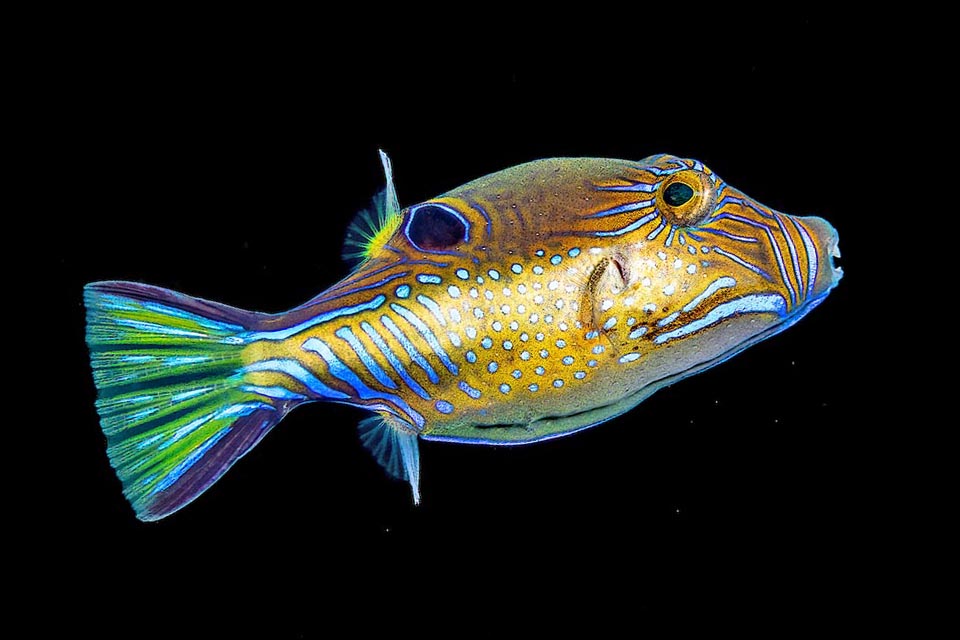
Known as Caribbean sharpnose-puffer, Canthigaster rostrata can reach 12 cm of length but usually measures much less © Allison & Carlos Estape
Canthigaster rostrata (Bloch, 1786), known as Caribbean sharpnose-puffer, belongs to the class of the Actinopterygii, the ray-finned fishes, to the order of the Tetraodontiformes and to the family Tetraodontidae where the genus Canthigaster stands out with approximately forty species over about 200.
The etymology of Canthigaster originates from the Greek “κανθήλια” (kanthelia), basket, and “γαστήρ”, (gaster), belly, due to the capacity this fish has of pumping water or air into the belly inflating it like a balloon. A way for becoming cumbersome to predators, who, moreover, will have to deal with the small spines of the tense belly. Furthermore, it is not easy to bite an elusive ball among the waves.
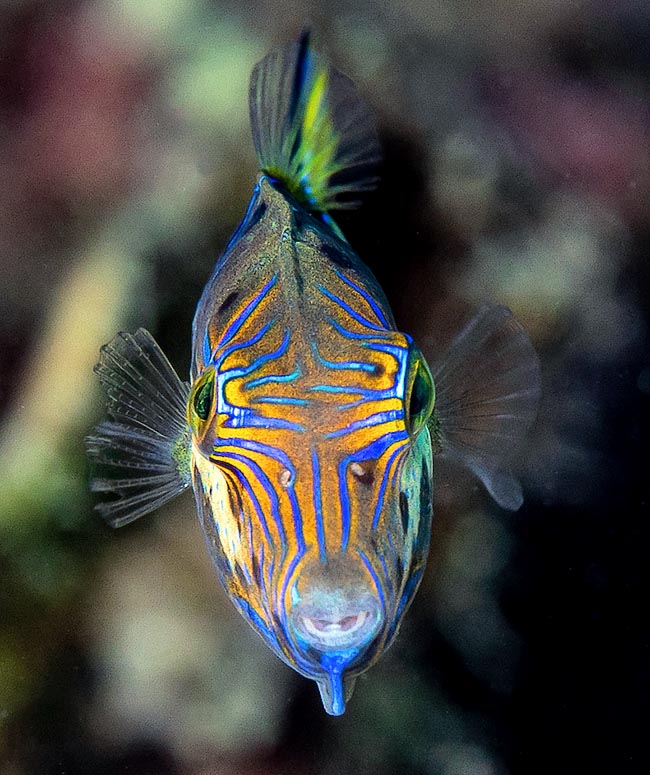
This is a male in the typical intimidating position, upside down position, with erection of the dorsal and ventral crest © Allison & Carlos Estape
The specific term rostrata comes from the Latin “rostratus”, equipped with a rostrum, with reference to the pointed snout as the vulgar name states.
Zoogeography
Canthigaster rostrata is essentially a Caribbean fish, present from South Carolina and the Bermudas up to Venezuela coasts and the Lesser Antilles.
Ecology-Habitat
It lives in relatively shallow waters, among the madreporic formations that grant hideouts and in the submerged prairies of phanerogams. Usually it does not go deeper than 30-40 m of depth, even if a sighting at 90 m has been reported.
Morphophysiology
The Caribbean sharpnose-puffer is the smallest Canthigaster of the western tropical Atlantic. It does not exceed the 12 cm of length, with females no more than half as large.
In a recent study made by the Miami University, the big males reached 7 cm and the females 5 cm, and this is the most evident sexual dimorphism.
The structure of the body, tapered and slightly compressed on the sides, is the classical one of the pufferfishes: small armour, subcutaneous, scaleless and equipped only with the necessary openings for the eyes, the mouth, the fins, the gills and the anus.
The snout is particularly elongated, infundibuliform, with the mouth placed in an advanced position and the characteristic beak of the Tetraodontidae formed by 4 teeth: the two incisors of the upper jaw and the two of the lower one. All other teeth have been lost, gradually, throughout evolution whilst in their next of kin, the Diodontidae, these two last incisors have merged into a single solid one tooth per jaw.
The dorsal and the anal fins, unarmed like the pectoral ones, are placed in a very rear position. The pelvic fins are absent and the truncated caudal, slightly rounded, often closed in a fan shape, generally serves only as a rudder even if in dangerous situations can give a notable impulse to escape.
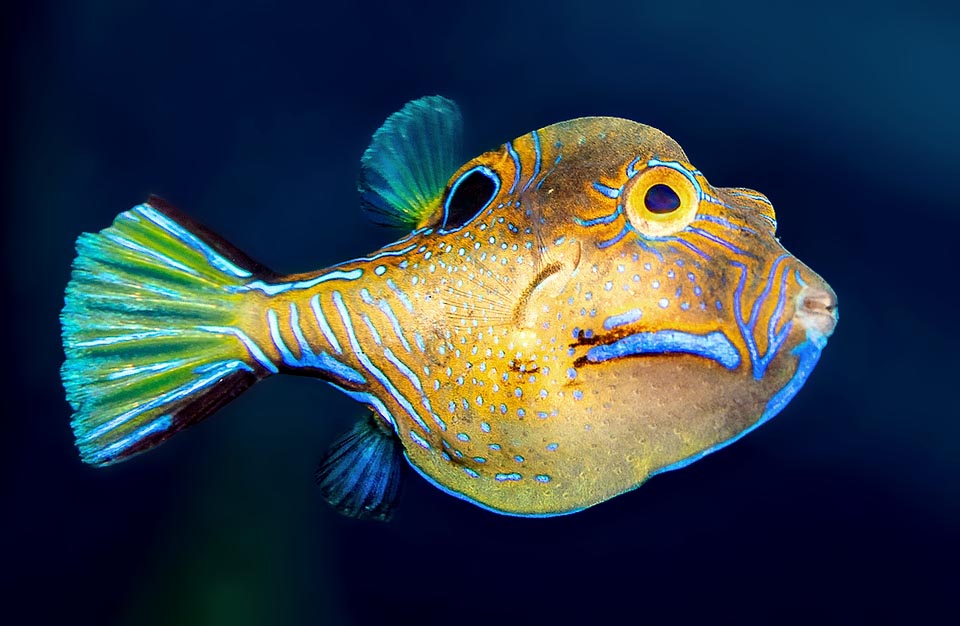
Despite the small size, Canthigaster rostrata in fact is a very territorial species with a dominant and aggressive male that assigns to a maximum of six females plots of its little kingdom, defended by biting its neighbours, as shows in this picture the missing crescent-shaped piece, cleanly cut on top of the caudal fin © Allison & Carlos Estape
The social life of Canthigaster rostrata is based on a visual language codified by precise and rapid changes in colour of the livery in part known.
The latter, together with the vertical stretching of the body, reports immediately on sight, for instance, the one commanding in that area whilst a suddenly mottled drawing is seen as an act of submission: a safe-conduct for the one who must rapidly cross the others’ territory or at times a female’s availability for mating.
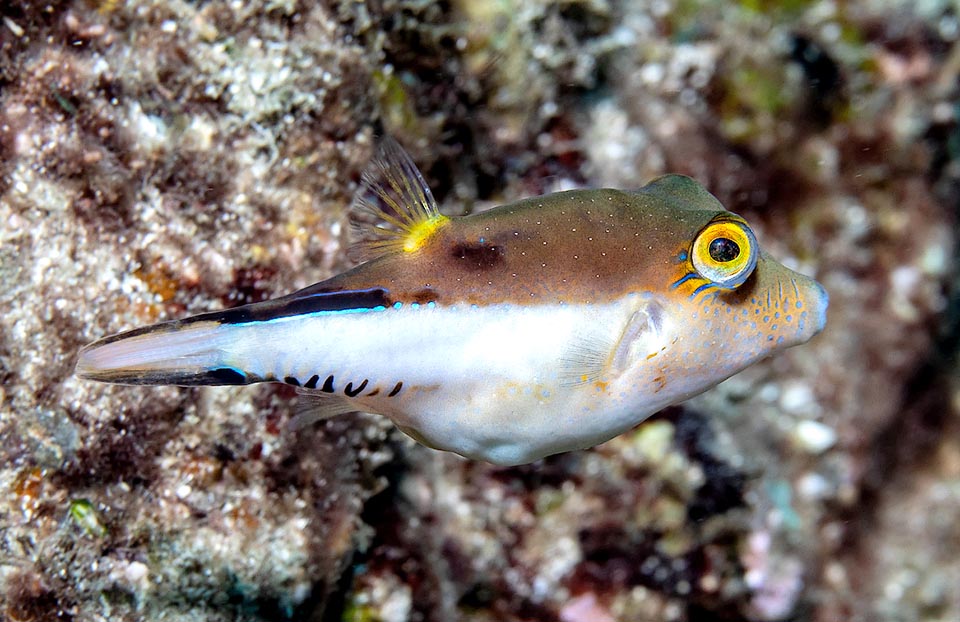
This is a female, judging by the belly appearing full of eggs. Smaller than the male, it has a livery similar to the juvenile phase of the species © Allison & Carlos Estape
In fact, in its own small way, Canthigaster rostrata is a very territorial fish.
Each female owns a fiefdom it defends from intruders, inserted in the vaster range of an alpha male.
This one every day visits its own harem that may count even 6 females and monitors relentlessly the limits of its kingdom with bites that often leave unmistakable crescent-shaped notches on the tail of the intruders or circular scars on their body. A job consuming energies and at risk, so much so that in nature the females live longer than the males reaching even 10 years of age.
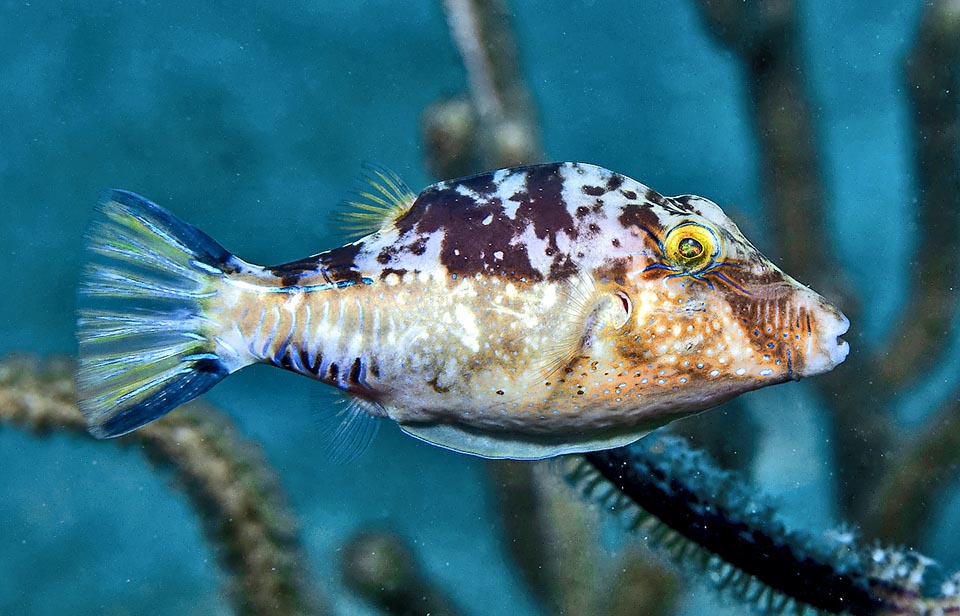
Conversely this is the typical submission mottled livery, taken on by the one who must cross quickly others’ territory © Allison & Carlos Estape
The young males wander submissively until they find a free zone to occupy or inherit a kingdom.
Normally, the Caribbean sharpnose-puffer background colour is brown around the back and much paler, basically white, in the lower part.
There is a characteristic dark longitudinal stripe, more or less continuous, starting on the sides aligned to the end of the dorsal fin to reach the upper side of the caudal, and a symmetrical second one from the lower side of the latter towards the anal.
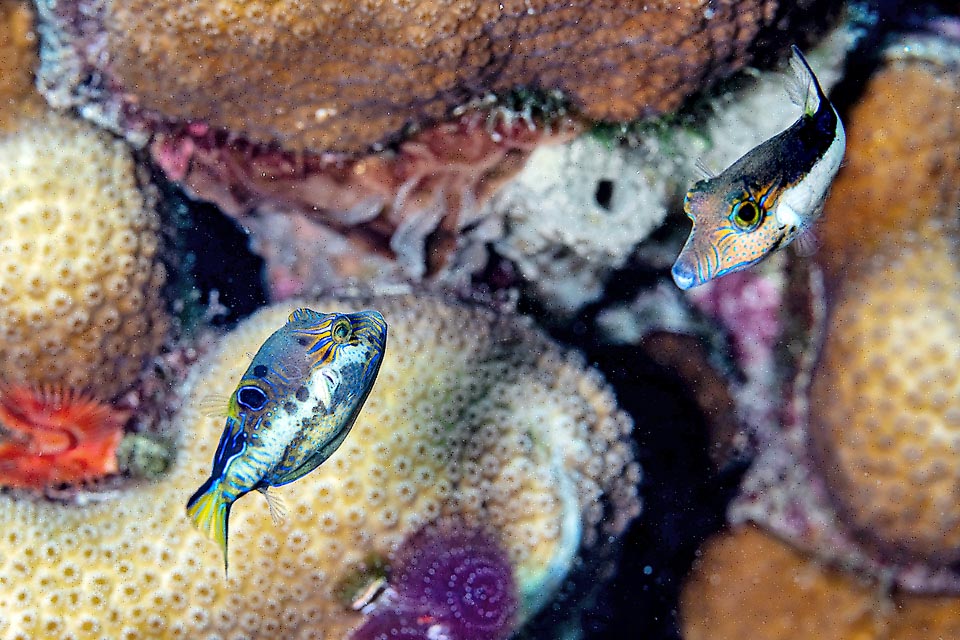
Otherwise it’s fight, as shown by these two males looking each other askance © Allison & Carlos Estape
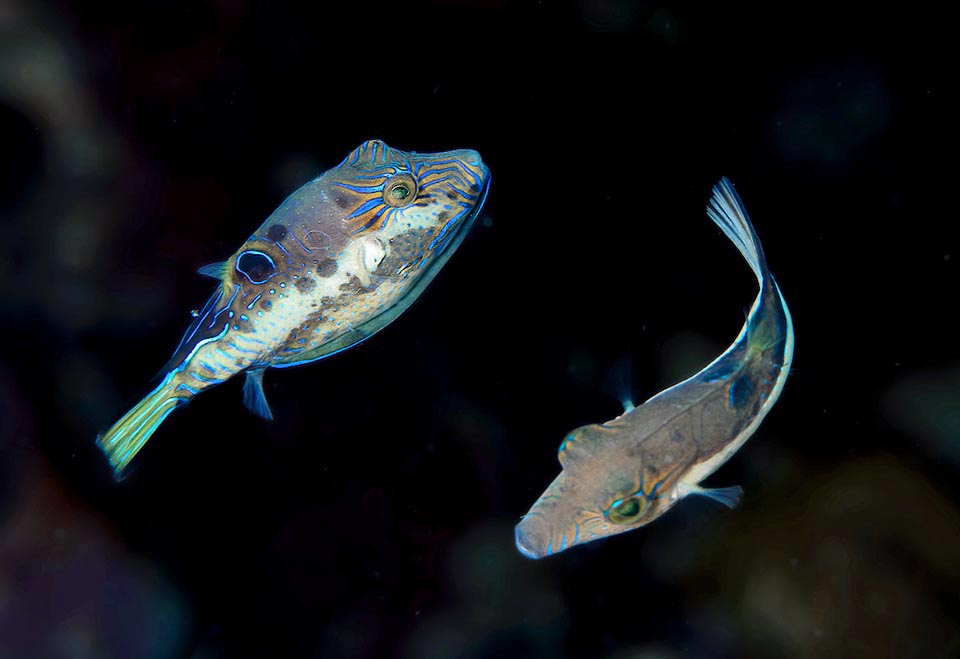
Then, if the invader of the territory doesn’t desist, they move in circles to show their prowess © Allison & Carlos Estape
The central part of the caudal is yellowish, without the vertical blue lines that conversel appear on the peduncle and come up again inclined towards the belly until they transform into dotting. Similar blue traits depart radially from the eye adorning the head and the back, except to transform suddenly into the submission mottled drawing.
Ethology-Reproductive Biology
Canthigaster rostrata is omnivorous. It feeds on algae and aquatic plants, sponges and other small invertebrates like, for instance, polychaetous annelids, shrimps, crabbs, stars and sea urchins, soft corals and holothurians.
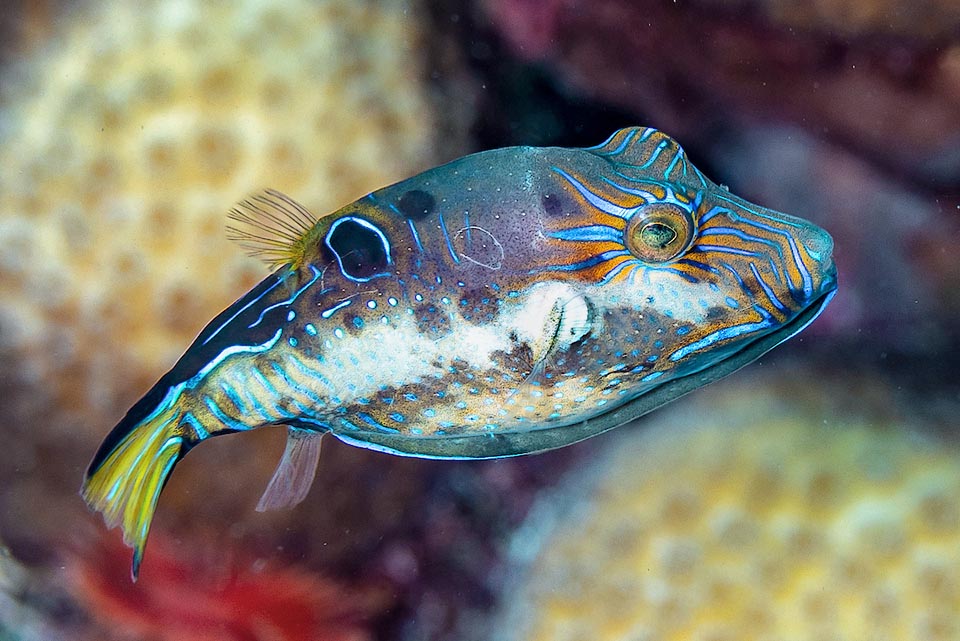
This male has two scars on the back. One close to the dorsal fin and the other, more evident, between this and the eye © Allison & Carlos Estape
In their turn they are swallowed whole, casually, by fishes like the Great barracuda (Sphyraena barracuda), the Scorpionfish or Red lionfish (Pterois volitans) and the Green sea turtle (Chelonia mydas), but the Caribbean sharpnose-puffer defends itself from these predators with powerful venoms: the tetrodotoxin, typical of the pufferfishes, and the saxitoxin, a highly toxic alkaloid produced by dinoflagellates that enter into their diet and they too block breathing.
As a matter of fact, they have found several Chelonia mydas dead with abundant remains of Canthigaster rostrata in their stomach and when the predator survives will remember in the future not to attack such a strange colour fish that swells.
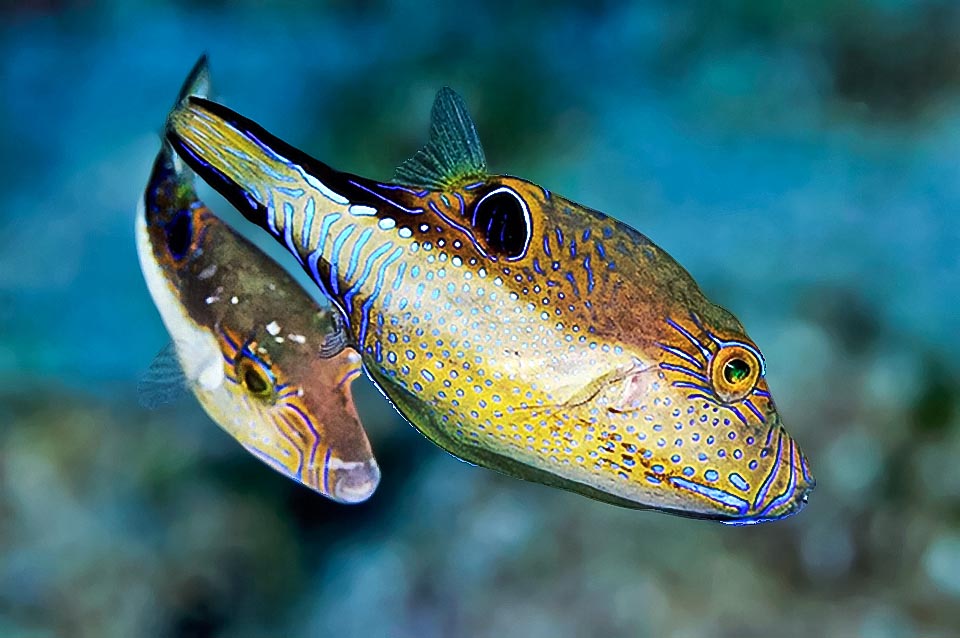
A couple. The male, besides defending the boundaries of its kingdom, visits every day its harem to see if there are females ready to spawning © Allison & Carlos Estape
For the reproduction the female, who lays small translucent eggs of about 0,7 mm, builds a nest of algae and chasing away the opportunistic young males waits for the alpha one to pass for fecundating them. The larvae measure about 1,4 mm.
Resilience is excellent, with a possible doubling of the populations in less than 15 months, and the fishing vulnerability index is very low, marking only 10 on a scale of 100. In the Red List of the endangered species Canthigaster rostrata consequently appears as “Least Concern”.
Synonyms
Tetrodon rostratus Bloch, 1786; Canthigaster rostratus (Bloch, 1786); Tetrodon ornatus Poey, 1867.
→ For general information about FISH please click here.
→ For general information about BONY FISH please click here
→ For general information about CARTILAGINOUS FISH please click here.
→ To appreciate the BIODIVERSITY of BONY FISH please click here.
→ To appreciate the BIODIVERSITY of CARTILAGINOUS FISH please click here.
